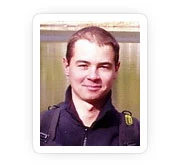Yoga Anatomy: Release the Internal Rotators for a Deeper Lotus Pose

Joint congruency and joint reaction forces are among the most important principles to understand for both practitioners and teachers because many poses can take the articulations to the limits of their range of motion. Take a moment to review this post to familiarize yourself with the concept of joint congruency and how it applies to Lotus Pose (Padmasana).

Releasing the Internal Rotators of the Hips
The main muscles that internally rotate the femur at the hip are the tensor fascia lata (TFL) and gluteus medius. The gluteus minimus contributes to this action when the hip is flexed. Conversely, when the internal rotators are tight, they can limit external rotation of the joint, a key component in poses like Lotus.
Practicing this asana without releasing the TFL and gluteus medius can lead to excessive joint reaction forces in the knee. This is because the rotational component of the pose is directed into the knee. The key is to use the hip (which is a ball-and-socket joint) to do the rotation while protecting the knee by maintaining it as a hinge.
Tensor fascia lata and gluteus medius stretching. (photo left)
How to Practice Cradle Stretch
To release the TFL and gluteus medius, I use a technique called the “cradle stretch.”

Cradle stretch with inset of peronei contracting to evert the foot. (photo right)
- Lift the lower leg, as shown here. This action externally rotates the hip. Do not allow the knee to sag forward away from the body—this is important.
- Cradle it in the crook of the elbow so that the knee is maintained as a hinge. Place the outer edge of the foot into the crook of the other elbow, and engage the peroneus longus and brevis muscles at the outside of the lower leg to evert the foot.
- Extending the toes also helps. This aids to maintain the congruency of the knee joint and helps to protect it from injury.
- Take the leg to a point where you feel a moderate stretch in the muscles at the outside of the hip—the TFL and gluteus medius.
- Hold this position by contracting the biceps, pectoralis major, and latissimus dorsi (shown in blue). Then gradually start to press the edge of the foot into the forearm, as if you were trying to bring it away from the body. This activates the stretching TFL and gluteus medius (shown in red).
- Build the contraction of these muscles slowly to about 20 percent of your maximum force (or less).
- Take 4 to 5 smooth, deep breaths, and then stop pressing the foot into the forearm. At this point, you will have elicited the relaxation response through stimulating the Golgi tendon organ at the muscle-tendon junction.
- Then “take up the slack” by gradually lifting the foot a little higher and drawing the knee a bit further across the body. Hold this new position for a few breaths.
- Continue to protect the knee as you take it out to the side, bend it, and place it on the floor. Feel the difference between the two hips.
- Repeat on the other side. Contracting and releasing the stretching muscles uses proprioceptive neuromuscular facilitation to lengthen the hip internal rotators.
Variations on Cradle Pose (Lotus Pose Stretch)
If you are unable to cradle the leg, as shown above, don’t despair, and don’t force it. Use the variation illustrated below with the mannequin. Protect the knee with one hand and press the edge of the foot into the other hand. Work like this for as many sessions as necessary until the TFL and gluteus medius have released enough to move into the full cradle.
The lower back can tend to collapse into flexion when practicing this stretch. Engaging the erector spinae and quadratus lumborum muscles (extensors of the lumbar spine) will help to protect against this. Note how slightly extending the lumbar also accentuates the stretch of the TFL and gluteus medius.

Alternative cradle for tight hips. ( photo left)
Remember to go slowly with proprioceptive neuromuscular facilitation. Allow about 48 hours for recovery before repeating the technique on any given muscle group. It takes a few sessions for the new length to be ingrained in the body, so don’t get discouraged if you feel a bit tight again when you come back to this position.
Reprinted with permission from Daily Bandha.
Illustrations by the Daily Bandha.
 Author Ray Long MD, FRCSC is a board-certified orthopedic surgeon and the founder of Bandha Yoga. Ray graduated from The University of Michigan Medical School with post-graduate training at Cornell University, McGill University, The University of Montreal and Florida Orthopedic Institute. He has studied hatha yoga for over twenty years, training extensively with B.K.S. Iyengar and other leading yoga masters.
Author Ray Long MD, FRCSC is a board-certified orthopedic surgeon and the founder of Bandha Yoga. Ray graduated from The University of Michigan Medical School with post-graduate training at Cornell University, McGill University, The University of Montreal and Florida Orthopedic Institute. He has studied hatha yoga for over twenty years, training extensively with B.K.S. Iyengar and other leading yoga masters.
 3d Graphic Designer / Illustrator Chris Macivor has been involved in the field of digital content creation for well over ten years. He is a graduate of Etobicoke School of the Arts, Sheridan College and Seneca College. Chris considers himself to be equally artistic and technical in nature. As such, his work has spanned many genres from film and television to video games and underwater imagery.
3d Graphic Designer / Illustrator Chris Macivor has been involved in the field of digital content creation for well over ten years. He is a graduate of Etobicoke School of the Arts, Sheridan College and Seneca College. Chris considers himself to be equally artistic and technical in nature. As such, his work has spanned many genres from film and television to video games and underwater imagery.



